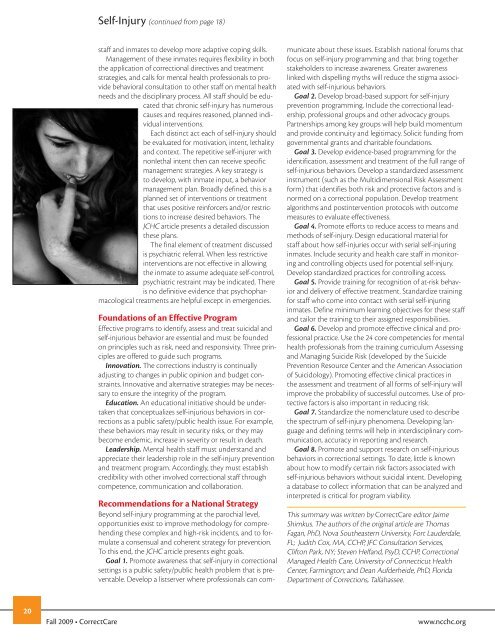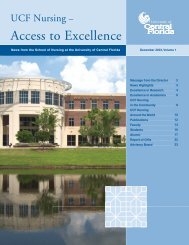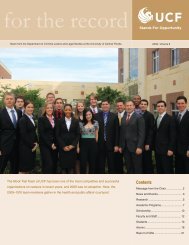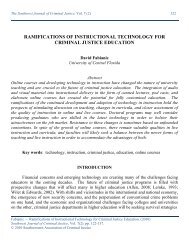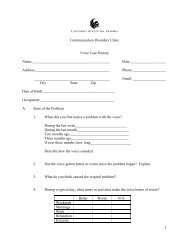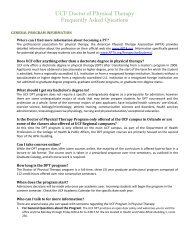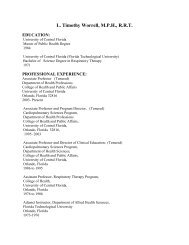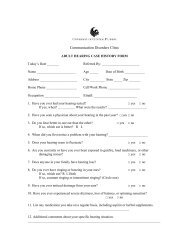Fall - National Commission on Correctional Health Care
Fall - National Commission on Correctional Health Care
Fall - National Commission on Correctional Health Care
Create successful ePaper yourself
Turn your PDF publications into a flip-book with our unique Google optimized e-Paper software.
(c<strong>on</strong>tinued) Self-Injury (c<strong>on</strong>tinued from page 18)staff and inmates to develop more adaptive coping skills.Management of these inmates requires flexibility in boththe applicati<strong>on</strong> of correcti<strong>on</strong>al directives and treatmentstrategies, and calls for mental health professi<strong>on</strong>als to providebehavioral c<strong>on</strong>sultati<strong>on</strong> to other staff <strong>on</strong> mental healthneeds and the disciplinary process. All staff should be educatedthat chr<strong>on</strong>ic self-injury has numerouscauses and requires reas<strong>on</strong>ed, planned individualinterventi<strong>on</strong>s.Each distinct act each of self-injury shouldbe evaluated for motivati<strong>on</strong>, intent, lethalityand c<strong>on</strong>text. The repetitive self-injurer withn<strong>on</strong>lethal intent then can receive specificmanagement strategies. A key strategy isto develop, with inmate input, a behaviormanagement plan. Broadly defined, this is aplanned set of interventi<strong>on</strong>s or treatmentthat uses positive reinforcers and/or restricti<strong>on</strong>sto increase desired behaviors. TheJCHC article presents a detailed discussi<strong>on</strong>these plans.The final element of treatment discussedis psychiatric referral. When less restrictiveinterventi<strong>on</strong>s are not effective in allowingthe inmate to assume adequate self-c<strong>on</strong>trol,psychiatric restraint may be indicated. Thereis no definitive evidence that psychopharmacologicaltreatments are helpful except in emergencies.Foundati<strong>on</strong>s of an Effective ProgramEffective programs to identify, assess and treat suicidal andself-injurious behavior are essential and must be founded<strong>on</strong> principles such as risk, need and resp<strong>on</strong>sivity. Three principlesare offered to guide such programs.Innovati<strong>on</strong>. The correcti<strong>on</strong>s industry is c<strong>on</strong>tinuallyadjusting to changes in public opini<strong>on</strong> and budget c<strong>on</strong>straints.Innovative and alternative strategies may be necessaryto ensure the integrity of the program.Educati<strong>on</strong>. An educati<strong>on</strong>al initiative should be undertakenthat c<strong>on</strong>ceptualizes self-injurious behaviors in correcti<strong>on</strong>sas a public safety/public health issue. For example,these behaviors may result in security risks, or they maybecome endemic, increase in severity or result in death.Leadership. Mental health staff must understand andappreciate their leadership role in the self-injury preventi<strong>on</strong>and treatment program. Accordingly, they must establishcredibility with other involved correcti<strong>on</strong>al staff throughcompetence, communicati<strong>on</strong> and collaborati<strong>on</strong>.Recommendati<strong>on</strong>s for a <str<strong>on</strong>g>Nati<strong>on</strong>al</str<strong>on</strong>g> StrategyBey<strong>on</strong>d self-injury programming at the parochial level,opportunities exist to improve methodology for comprehendingthese complex and high-risk incidents, and to formulatea c<strong>on</strong>sensual and coherent strategy for preventi<strong>on</strong>.To this end, the JCHC article presents eight goals.Goal 1. Promote awareness that self-injury in correcti<strong>on</strong>alsettings is a public safety/public health problem that is preventable.Develop a listserver where professi<strong>on</strong>als can communicateabout these issues. Establish nati<strong>on</strong>al forums thatfocus <strong>on</strong> self-injury programming and that bring togetherstakeholders to increase awareness. Greater awarenesslinked with dispelling myths will reduce the stigma associatedwith self-injurious behaviors.Goal 2. Develop broad-based support for self-injurypreventi<strong>on</strong> programming. Include the correcti<strong>on</strong>al leadership,professi<strong>on</strong>al groups and other advocacy groups.Partnerships am<strong>on</strong>g key groups will help build momentumand provide c<strong>on</strong>tinuity and legitimacy. Solicit funding fromgovernmental grants and charitable foundati<strong>on</strong>s.Goal 3. Develop evidence-based programming for theidentificati<strong>on</strong>, assessment and treatment of the full range ofself-injurious behaviors. Develop a standardized assessmentinstrument (such as the Multidimensi<strong>on</strong>al Risk Assessmentform) that identifies both risk and protective factors and isnormed <strong>on</strong> a correcti<strong>on</strong>al populati<strong>on</strong>. Develop treatmentalgorithms and postinterventi<strong>on</strong> protocols with outcomemeasures to evaluate effectiveness.Goal 4. Promote efforts to reduce access to means andmethods of self-injury. Design educati<strong>on</strong>al material forstaff about how self-injuries occur with serial self-injuringinmates. Include security and health care staff in m<strong>on</strong>itoringand c<strong>on</strong>trolling objects used for potential self-injury.Develop standardized practices for c<strong>on</strong>trolling access.Goal 5. Provide training for recogniti<strong>on</strong> of at-risk behaviorand delivery of effective treatment. Standardize trainingfor staff who come into c<strong>on</strong>tact with serial self-injuringinmates. Define minimum learning objectives for these staffand tailor the training to their assigned resp<strong>on</strong>sibilities.Goal 6. Develop and promote effective clinical and professi<strong>on</strong>alpractice. Use the 24 core competencies for mentalhealth professi<strong>on</strong>als from the training curriculum Assessingand Managing Suicide Risk (developed by the SuicidePreventi<strong>on</strong> Resource Center and the American Associati<strong>on</strong>of Suicidology). Promoting effective clinical practices inthe assessment and treatment of all forms of self-injury willimprove the probability of successful outcomes. Use of protectivefactors is also important in reducing risk.Goal 7. Standardize the nomenclature used to describethe spectrum of self-injury phenomena. Developing languageand defining terms will help in interdisciplinary communicati<strong>on</strong>,accuracy in reporting and research.Goal 8. Promote and support research <strong>on</strong> self-injuriousbehaviors in correcti<strong>on</strong>al settings. To date, little is knownabout how to modify certain risk factors associated withself-injurious behaviors without suicidal intent. Developinga database to collect informati<strong>on</strong> that can be analyzed andinterpreted is critical for program viability.This summary was written by Correct<strong>Care</strong> editor JaimeShimkus. The authors of the original article are ThomasFagan, PhD, Nova Southeastern University, Fort Lauderdale,FL; Judith Cox, MA, CCHP, JFC C<strong>on</strong>sultati<strong>on</strong> Services,Clift<strong>on</strong> Park, NY; Steven Helfand, PsyD, CCHP, Correcti<strong>on</strong>alManaged <strong>Health</strong> <strong>Care</strong>, University of C<strong>on</strong>necticut <strong>Health</strong>Center, Farmingt<strong>on</strong>; and Dean Aufderheide, PhD, FloridaDepartment of Correcti<strong>on</strong>s, Tallahassee.20<str<strong>on</strong>g>Fall</str<strong>on</strong>g> 2009 • Correct<strong>Care</strong>www.ncchc.org


